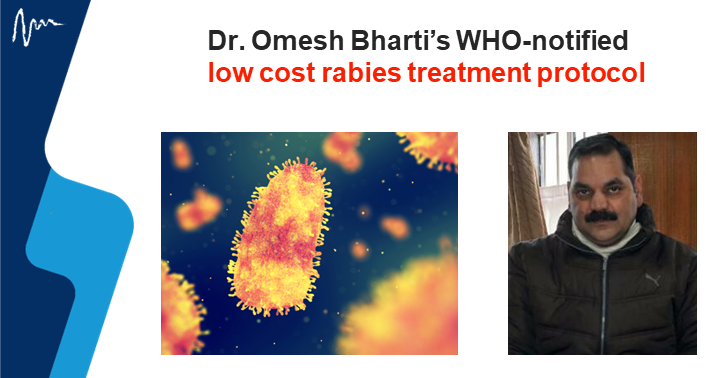Dr. Bharti discusses his WHO-notified low cost rabies treatment protocol
M3 India Newsdesk Feb 20, 2018
Dr. Omesh Kumar Bharti from the Directorate of Health Services, Himachal Pradesh has been awarded the Padma Shri, one of the highest honours in India for his work in devising an anti-rabies treatment that costs only 1% of the conventional treatment. Here he discusses the protocol and advantages of the new treatment.

The conventional treatment for rabies meant intramuscular injections sourced from human or horse blood, making it a rare and expensive prophylactic. The new treatment by Dr. Bharti uses intradermal spot injection in lesser quantities, making it more affordable.After a thorough verification, the World Health Organization (WHO) has also approved of it.
A rabid dog bite is a major cause of rabies, which is a highly contagious disease. Globally, about 59,000 people are killed annually because of rabies. Of these, India alone witnesses about 20,000 deaths a year. About 40% of these fatalities are children below the age of 15.
In this interview with M3 India, Dr. Bharti shares the importance and salient points of his innovation.
Why was the conventional treatment expensive?
Rabid Dog Bite Post-Exposure Prophylaxis is a medical process followed after a dog bites a human. In this process, the victim is given two kinds of injections. One is the rabies vaccine and the other is the rabies immunoglobulin. Immunoglobulins are produced primarily by plasma cells that are used by the immune system to neutralise pathogens such as pathogenic bacteria and virus. While the rabies vaccine is an intradermal injection, the immunoglobulin is injected into the wounds and the muscles both, which requires a large quantity of immunoglobulin for the patient. This, until this new and cheaper treatment, introduced by me, Dr. Bharti, was the conventional procedure.
Blame it on the large quantities of immunoglobulin needed for the wound as well as the muscle, for the high cost. Immunoglobulin is an antibody that is taken from either the human or the horse blood, therefore making it a deficient resource for the growing number of rabid dog bite cases. As a result, the cost of immunoglobulin shot to an unaffordable level for the financially weaker sections. Both its deficiency and high price were the major reasons for rising deaths because of rabies.
What is the treatment you have devised that has reduced rabies-related deaths in Himachal Pradesh, India?
What are the key advantages of the new research?
Dr. Bharti: The major cause of deaths because of rabies in India is its costly treatment. Secondly, the shortage of vaccine and immunoglobulin makes matters worse. More than about 60% of rabies patients belong to the poverty-stricken sections of the society. So, the need of the hour wasn’t just making the treatment affordable but also to make it accessible to each and every patient.
One of the two greatest benefits of the new research is that now the prophylaxis is nearly 100 times cheaper than the conventional treatment.
While the charges earlier were about Rs 35,000, today it is only Rs 350 for the new treatment. The deaths in Himachal owing to rabies have gone way down now and we are hopeful we will make our country rabies-free very soon.
How well-known is this new treatment of rabies across India?
Dr. Bharti: It was only a while ago that we succeeded in getting the new prophylaxis approved by WHO. So, many states in the country are yet to discover the new method. It will be nice to see the government of India promoting the new protocol through broadcast radio and advertisements.
Thailand is perhaps going to be the second country after India to implement the new protocol. Thanks to one of the co-authors in my paper, Dr. Henry Wilde, who is from Thailand. I got an email that somebody in Thailand has written a proposal to the government to implement the new protocol.
Interview reported by Rajat Kalra and Sat Singh (101Reporters team).
-
Exclusive Write-ups & Webinars by KOLs
-
Daily Quiz by specialty
-
Paid Market Research Surveys
-
Case discussions, News & Journals' summaries